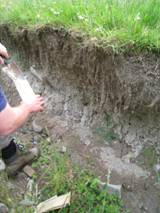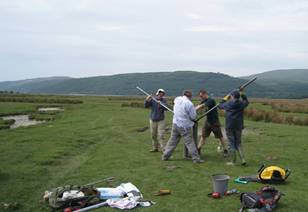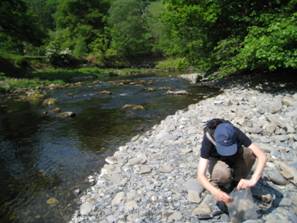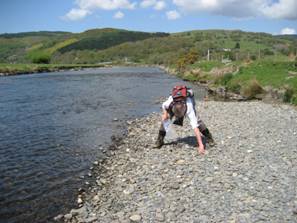Dyfi RETZ Project
Impacts of hydrological variability on material transfers through the River-Estuary Transition Zone
“This project will investigate how the physical properties of SPM determine the transfer from river catchments to the coastal zone of particulate biogenic and lithogenic materials derived from terrestrial weathering and erosion.” SPM = suspended particulate matter
Summary
Estuaries are biologically productive, susceptible to climatic variability, and vulnerable to nutrient enrichment. These characteristics are reinforced by their ability to trap, filter, and recycle particulate matter. The processing of particulate matter supplied to estuaries is therefore important and dependent on the major sources of material to estuaries. In this respect, suspended particulate matter (SPM) and its inherent chemical characteristics are instrumental in controlling the reactivity, transport, and biological impact of substances from river catchments to the coastal zone.
During transport to the coast, the physical properties of SPM (particle size, density, settling velocity) change on short time and length scales, especially when terrestrial particles encounter the steep hydrodynamic, chemical, and biological gradients that characterise the River-Estuarine Transition Zone (RETZ), and enter the estuary. This is because SPM is largely in the form of flocs: aggregates of inorganic matter, organic matter, and water. Flocs grow to a much larger size than their individual inorganic components. Aggregation occurs when fresh water meets salt water in the RETZ and is further mediated by biological effects. Flocs are created when individual particles collide due to weak turbulence, and are ruptured by strong turbulence. Large flocs sink rapidly, thus transferring material to the sediment bed. So, the fate of terrestrial SPM (i.e., whether it is retained by rivers, transferred to estuaries, or exported to the coastal ocean) is strongly influenced by floc properties, which, in turn, are dependent on their provenance and genesis. Since flocs are fragile and ruptured by sampling, they are difficult to study. High resolution measurements are needed since flocs change their properties on short time and length scales. This has been difficult to achieve, but optical techniques are now available which allow high resolution in situ measurement of floc properties (size, volume concentration), which, coupled with measurements of mass concentration and settling velocity, provide assessment of floc strength.
This project investigates the transfer from river catchments to estuaries of SPM and its particulate components (carbon, nitrogen, heavy metals). These terrestrial components are important for water quality and ecosystem functioning and health in the coastal zone, and are likely to be severely altered by changes to the fluvial regime - increased frequency of major flood events - driven by climate change. The study system is the Dyfi Catchment, located in Mid-Wales, UK.

The aims are to determine
(i) The varying provenance of riverine SPM, which changes seasonally and during episodic flood events, when material is mobilised, previously deposited on aerially exposed floodplains and high banks. We will use multiple geochemical proxies in the form of the C:N ratio, stable carbon isotopes, and the lignin-derived monomer yields of organic matter, as well as inorganic geochemical tracers in the form of heavy metals.
(ii) How floc properties and geochemical composition evolve as they pass through the RETZ and the estuary.
(iii) How flocs and material transfers respond to marine forcings (tidal, storm) and fluvial forcings, especially short duration (episodic) events. High resolution observational datasets from instrumented sampling sites in the catchment, RETZ, and estuary will be used to validate a 1-D vertical exchange model, which will be embedded in a 3-D hydrodynamic model for scenario testing of impacts of episodic river floods and storms on material transfers through the river-estuary system.
| Dyfi at high tide | Dyfi at low tide | |
 |
 |
Objectives
We hypothesize that seasonally & tidally varying floc properties influence their dynamic cycle within the River-Estuary-Transition Zone (RETZ), which determines the downstream transport and fate of TOM (Total Organic Matter). To this end, we propose the following objectives:
(1) To obtain a high quality dataset of Suspended Particulate Matter (SPM) properties (concentration, floc size, settling velocity, geochemical composition) in the river, RETZ, and estuary under varying conditions of river flow, tidal range, and storm/flood conditions.
(2) To identify the provenance of the lithogenic and biogenic components of the land-derived SPM in relation to catchment dynamics using multiple geochemical proxies in the form of the C:N, δ 13C, and the lignin-derived monomer yields of SPOM (Suspended Particulate Organic Matter), as well as inorganic geochemical tracers in the form of heavy metals.
(3) To determine the spatial and temporal variability of SPM properties and material transfer along the axis of the river-estuary, with special focus on the RETZ;
(4) To validate a 1-D turbulence closure model of SPM vertical flux and couple this to a 3-D hydrodynamic model for scenario testing of SPM and geochemical component-specific fluxes through the RETZ and estuary during short duration, episodic events.
Fieldwork season spring 2010 pictures
 |
 |
 |
 |
